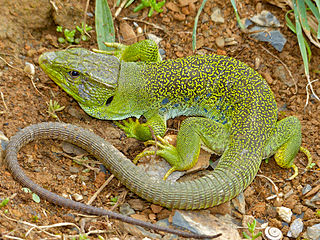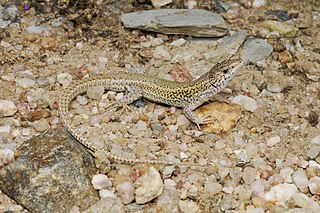
Lacerta is a genus of lizards of the family Lacertidae.

Podarcis is a genus of lizards in the family Lacertidae. Its members look very similar to lizards of the genus Lacerta, to which they were considered to belong until the 1970s. While similar externally and ecologically, Podarcis form a distinct group differing from Lacerta by the construction of the skull and the hemipenis, and by the processes of the caudal vertebrae. They are commonly known as wall lizards. They are native to Europe and northern Africa, and most species are restricted to the Mediterranean region. The Italian wall lizard and the common wall lizard have been introduced to North America.

Erhard's wall lizard, also called the Aegean wall lizard, is a species of lizard in the family Lacertidae. The species is endemic to Southeast Europe.

The ocellated lizard or jewelled lizard is a species of lizard in the family Lacertidae. The species is endemic to southwestern Europe.

Timon princeps, commonly called the Siirt lizard or the Zagrosian lizard, is a species of lizard in the family Lacertidae. The species is endemic to Western Asia.

Darevskia armeniaca, commonly known as the Armenian lizard or the Armenian rock lizard, is a parthenogenetic species of Darevskia, a genus of lizards belonging to the family Lacertidae, the wall lizards. Darevskia armeniaca is native to the Armenian Highland.

Bedriaga's rock lizard is a species of lizard in the family Lacertidae. The species is monotypic within the genus Archaeolacerta. It is only found on the islands Corsica and Sardinia. The name Lacerta bedriagae is also used.

The Gran Canaria giant lizard is a species of lizard in the family Lacertidae. The species is found in the Canary Islands.

Horvath's rock lizard is a species of lizard in the family Lacertidae. The species is endemic to Europe. Until recently, this species was assigned to the same genus as the morphologically similar sand lizard. The natural habitats of I. horvathi are temperate forests and shrublands, and rocky areas.

The Iberian rock lizard is a species of lizard in the family Lacertidae. The species is endemic to Portugal and Spain. Its natural habitats are mountain forests, shrubland, rivers and rocky areas. It is threatened by habitat loss.

Bocage's wall lizard is a species of lizard in the family Lacertidae. The species is endemic to the Iberian Peninsula. Its natural habitats are temperate forests, temperate shrubland, Mediterranean-type shrubby vegetation, sandy shores, rural gardens, and urban areas. The IUCN does not consider it to be threatened.

Podarcis carbonelli, commonly known as Carbonell's wall lizard, is a species of lizards in the family Lacertidae. It is endemic to Portugal and Spain.

The Skyros wall lizard is a species of lizards in the family Lacertidae. The species is endemic to the islands of Skyros and Piperi, Greece.

Lilford's wall lizard is a species of lizard in the family Lacertidae. The species is endemic to the Balearic Islands, Spain.

The Aeolian wall lizard, also known commonly as Raffone's wall lizard, is a species of lizard in the family Lacertidae. The species is endemic to Italy.

The Sicilian wall lizard is a species of lizard in the family Lacertidae. Endemic to Italy, it occurs in Sicily and the Aegadian Islands. Its natural habitats are temperate forests, temperate shrubland, Mediterranean-type shrubby vegetation, temperate grassland, arable land, pastureland, and rural gardens. The IUCN does not consider it to be a threatened species. Three subspecies are recognized: P. w. antoninoi, P. w. marettimensis and P. w. waglerianus.

















